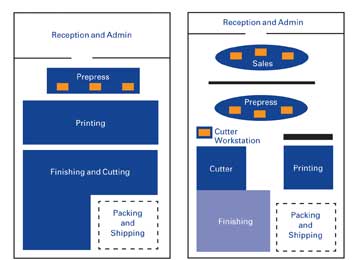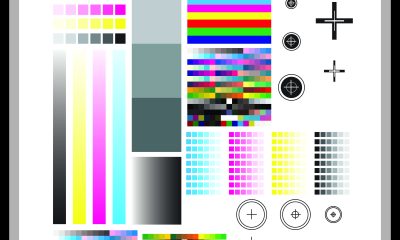News & Trends
How to Get More from Your Floor
Published
13 years agoon

The ways in which work flows through your plant influences efficiency. If the flow through the shop creates natural interactions between staff in prepress, printing, finishing, and shipping, success is inevitable. But before you completely rearrange your plant, decide how you would like your teams to interact and how the flow of communications will mold the final product.
The ways in which work flows through your plant influences efficiency. If the flow through the shop creates natural interactions between staff in prepress, printing, finishing, and shipping, success is inevitable. But before you completely rearrange your plant, decide how you would like your teams to interact and how the flow of communications will mold the final product.
Our world of custom, large-format, digital printing allows and requires a number of planners to throw ideas out on the best way to produce a project. The materials and print methodology is not so cut and dried. Quotes are expected in hours, not days, and projects are turned same day. The natural progression is that certain people develop an expertise in one area and others get good at different elements of the business. The work environment becomes the conduit for interaction.
Digital print production has evolved within the skill sets of our people—sales expectations, production coordination or customer service, prepress people, the printing department, and finishing. Solid knowledge is expected in prepress, while prepress people are also doing the printing. The critical part of the digital cutting process also relies on that original file. Wouldn’t it be great if communication were effortless within the prepress, printing, and finishing environments? All three are intertwined and depend on the original digital files. Even the sales group deals with files. My company arms sales with the capability to grab files from the FTP server, view them for an initial evaluation, and then place them on our production server. Our clients expect the sales group to be consultative not only in printing and materials for the final product, but also with digital imagery within the file.
Experts agree that there is no one-size-fits-all formula for designing the ideal workplace. However, they fall into two divided camps when it comes to a fundamental aspect of apportioning space. One group looks to a return to private offices; the other promotes completely open offices. Interestingly, these groups are united in their disdain for what some might consider a compromise position—cubicles, the office environment most commonly used by employers. Currently, an estimated 70% of workers spend their time in cubicles. They provide pseudo-privacy at best and are terrible for spontaneous communication.
AdvertisementCubicles are acoustic sieves that intrude on your thoughts and conversations. Usually, you can’t see the person in the cube next to you unless you stand up; therefore, you can hear as if the walls were not there but have a tendency to want to see what you hear. The dilemma is the ability to do distraction-free work for teams and individuals versus the ability to have easy, frequent, informal interactions. The answer relates to the personalities of the team. There’s isn’t one answer for every shop, though I believe that our printing business is assisted by the open concept.
Create a physical workflow that mirrors the changes in day-to-day activities that locate critical people within earshot and eyeshot. Classic horizontal layout of admin to sales to customer service to prepress to print to finishing to shipping (Figure 1) leaves gaps in collaboration. Prepress and digital cutting will not interact effectively when the job comes to the shop to figure the best way to layout the finishing system. If the location is close, the operators will not have to make a significant effort to evaluate the methodology. We call it putting two eyes on the file.
The linear structure of the horizontal workflow can morph into a shape that emulates the business units of modern manufacturers. The unit consists of production, sales, and customer service in one location to serve specific clients or business types. The business has multiple teams to manage the workflow that is unique to their talents. And this is our goal, which is to manage the workflow of large-format digital printing. The challenge is to position each person to promote interaction while allowing plenty of space for the large imagery we all produce.
Figure 2 incorporates the thought process of locating sales/customer service in the vicinity of the prepress people and the front end (electronics/work station) of digital cutting facing the prepress group. Digital printing equipment is in viewing distance of the prep department to allow continuous monitoring, as well as multitasking with files during printing. Finishing is also within viewing distance to encourage the second pair of eyes on what comes off the press. Try to get away from the straight lines of multiple computers and cubicles; instead, create a semi-curved, circular space that may share large tables or even a coffee machine. It is amazing how we save the world with a coffee cup in our hand.
What we are really doing is knocking down the walls of conventional manufacturing—figuratively and literally. Walls and cubicles prevent collaboration in our environment. But can we introduce too much interaction? Depending on the personalities of the operators, some amount of personalized space is important. What we are talking about is cubicles versus open spaces for the work environment.
The sales group tends to be on the phone quite a bit; therefore, this area can get a bit loud. Prepress/creative people like to focus and not to be interrupted. Interior-design techniques aid in sound deadening, and translucent office barriers can give the illusion of privacy while encouraging interaction. To add to these interesting architectural effects is that we may be able to print them in house. Is there a better way to present to our clients creative graphics than to show wonderful imagery within our facility? Show areas are great, but innovative uses for our products are great sales techniques.
AdvertisementGenerational tendencies may require personalization of the space. Baby Boomers (born between 1945-1963) have been characterized as individuals who believe that hard work and sacrifice are the price to pay for success. They also like teamwork, collaboration, and group decision-making. Generation X, defined as consisting of individuals born between 1968-1982, aspire more than previous generations to achieve a balance between work and home life and are more independent, autonomous, and self-reliant than previous generations. They value continuous learning and skill development. They have strong technical skills and are results focused. Although they are individualistic, they may also like teamwork, more so than Boomers.
Generation Y or Millennial is birthdays in 1983-2002. One of the most frequently reported characteristics of this generation is their comfort with technology. In general, Generation Y shares many of the characteristics of Xers. They are purported to value teamwork and collective action and are adaptable to change, though less process focused. Xers use technology, and the Yers assume technology.
The Boomers like to be face to face, use the phone, and have adapted to e-mail. Xers tend to use technology, but the Yers will text or e-mail you, even if you are sitting right next door. Face-to-face communication skills are not their best attribute. Generation X likes a casual and friendly work environment, while the Y Generation prefers support and structure. X and Y tend to be more individualistic (hide behind the computer screen) where the Boomers can be easily drawn out for collaboration.
This takes us back to cube or open spaces. Researching the general thoughts of architects and developers, I found the following perceptions:
On the negative side of cubicles:
• They stifle creativity.
• They are bland and uninspiring.
• They are demeaning to humans.
• They don’t promote interaction.
For the promoters of cubicles or personal space:
• They provide individual space.
• More space for shelves and manuals
• Wall space for posting diagrams and other documentation
• Easier to concentrate
• Less distraction
Other comments elaborate on lack of a private conversation area and the need for personal space. A layout design that allows for multiple conference rooms may be the solution for private conversations and quiet, personal phone calls, and just a place to get away from the buzz.
A flexible environment that can be modified easily is a must. The overriding focus is to keep everyone close and engaged in each project. The experts on workplace efficiency and environment agree to disagree. The topic of open space or offices will continue with the different flavors of lean manufacturing and changes in technology.
The human element and personalities need to be addressed, as well as the culture of each individual company. Generational characteristics of the operators are part of the fabric of the company culture. Does your company produce similar parts and pieces every day, or are you a custom-graphics provider that requires constant interaction? The floor plan will take shape once you identify who you are and what you want to be. If you do choose an open concept, allow for locations where employees can get away, think, and create in silence.

SPONSORED VIDEO
Let’s Talk About It
Creating a More Diverse and Inclusive Screen Printing Industry
LET’S TALK About It: Part 3 discusses how four screen printers have employed people with disabilities, why you should consider doing the same, the resources that are available, and more. Watch the live webinar, held August 16, moderated by Adrienne Palmer, editor-in-chief, Screen Printing magazine, with panelists Ali Banholzer, Amber Massey, Ryan Moor, and Jed Seifert. The multi-part series is hosted exclusively by ROQ.US and U.N.I.T.E Together. Let’s Talk About It: Part 1 focused on Black, female screen printers and can be watched here; Part 2 focused on the LGBTQ+ community and can be watched here.
You may like
Advertisement

Arcus Printers Barracuda Conveyor Flatbed Cutter

The Profit Impact of a Market Dominating Position

Inkcups Announces New CEO and Leadership Restructure
Advertisement
Subscribe

Bulletins
Get the most important news and business ideas from Screen Printing magazine's news bulletin.
Advertisement
Most Popular
-

 Case Studies2 months ago
Case Studies2 months agoHigh-Density Inks Help Specialty Printing Take Center Stage
-

 Art, Ad, or Alchemy2 months ago
Art, Ad, or Alchemy2 months agoF&I Printing Is Everywhere!
-

 Andy MacDougall2 months ago
Andy MacDougall2 months agoFunctional and Industrial Printing is EVERYWHERE!
-

 Columns3 weeks ago
Columns3 weeks ago8 Marketing Mistakes Not to Make When Promoting Your Screen Printing Services Online
-

 Editor's Note3 weeks ago
Editor's Note3 weeks agoLivin’ the High Life
-

 Marshall Atkinson3 weeks ago
Marshall Atkinson3 weeks agoHow to Create a Winning Culture in Your Screen-Printing Business
-

 Thomas Trimingham2 months ago
Thomas Trimingham2 months ago“Magic” Marketing for Screen Printing Shops
-

 Case Studies3 weeks ago
Case Studies3 weeks agoScreen Printing for Texture and Depth












